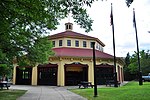Mater Dolorosa Parish, Holyoke
Buildings and structures in Holyoke, MassachusettsChurches in Hampden County, MassachusettsFormer Roman Catholic church buildings in MassachusettsMassachusetts church stubsPolish-American Roman Catholic parishes in Massachusetts ... and 2 more
Roman Catholic parishes of Diocese of Springfield in MassachusettsUnited States Roman Catholic church stubs

Mater Dolorosa Parish was a Roman Catholic parish designated for Polish immigrants in Holyoke, Massachusetts, United States. Founded 1896. It is one of the Polish-American Roman Catholic parishes in New England in the Diocese of Springfield in Massachusetts. The architect for this church was George P. B. Alderman of Holyoke, MA. According to the May 15, 2011 parish bulletin, the final mass was said on Sunday, June 26, 2011. "MD's" (as parishioners call it colloquially) merged with Holy Cross to form the new Our Lady of the Cross Parish.
Excerpt from the Wikipedia article Mater Dolorosa Parish, Holyoke (License: CC BY-SA 3.0, Authors, Images).Mater Dolorosa Parish, Holyoke
Lyman Street, Holyoke
Geographical coordinates (GPS) Address Nearby Places Show on map
Geographical coordinates (GPS)
| Latitude | Longitude |
|---|---|
| N 42.21 ° | E -72.606388888889 ° |
Address
Lyman Street 174;180
01040 Holyoke
Massachusetts, United States
Open on Google Maps










